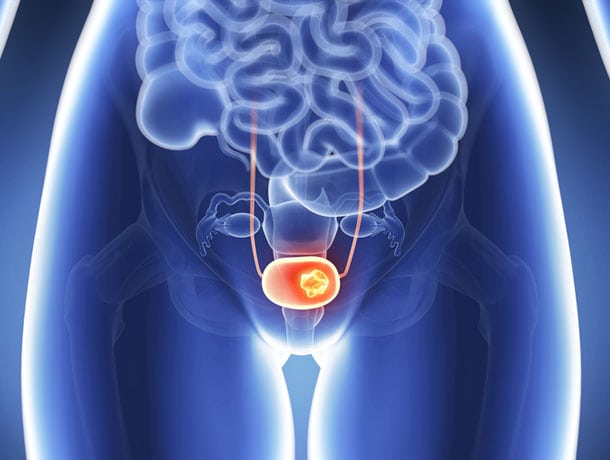

Frequent and painful urination is a common symptom of many urinary tract problems, including bladder cancer.
Located in the lower abdomen and connected to the kidneys by tubes called ureters, the bladder is the organ that holds urine. When cancer develops in this area, it usually begins within the lining of bladder’s muscular wall. It sometimes passes through this lining and affects other organs and tissues, including the lymph nodes, liver, and lungs.
Nearly 80,000 people are diagnosed annually with bladder cancer in the United States.
What Causes Bladder Cancer?
Despite being associated with several common cancer risk factors, bladder cancer doesn’t always have a clear cause or source. Some patients may develop abnormal cells from previous exposure to radiation, while others might have a history of chronic irritations affecting the lining of the bladder. There are three main types of bladder cancer:
- Urothelial carcinoma: The most common type of bladder cancer, urothelial carcinoma develops within the inner lining of the bladder.
- Squamous cell carcinoma: Associated with persistent infections, squamous cell carcinoma is rare and usually not life-threatening.
- Adenocarcinoma: Originating in mucus-secreting glands within the bladder, this form of cancer is also considered rare.

What Are Signs of Bladder Cancer?
In addition to pelvic pain or discomfort while urinating (dysuria), signs of bladder cancer may include pain on the right or left side of the body and blood in urine (hematuria). Since these symptoms don’t always mean that bladder cancer is involved, it’s important for patients to see their regular doctor or seek an evaluation from a urologist.
How Is It Diagnosed?
Diagnosis of bladder cancer typically starts with a detailed physical examination. A cystoscopy may be performed to view the urethra and bladder to look for signs of abnormal growths. A tissue sample called a biopsy may be collected and tested to determine if the growth is cancerous. Results from urine and blood tests are often combined with results from CT and MRI scans, bladder X-rays, or CT urograms performed with a contrast dye to make a positive diagnosis. A retrograde pyelogram may also be done to get a detailed view the upper urinary tract.
What Are Treatment Options?
Treatment for bladder cancer depends on the stage of cancer, where it’s specifically located within the bladder, and whether or not it’s growing rapidly. Cancer limited to a single area of the bladder such as the lining may be treated with chemotherapy or a combination of chemo and radiation therapy. Surgery may involve removal of the tumor with a minimally invasive radical cystectomy. Bladder removal is sometimes coupled with urinary tract reconstruction surgery. For instances when surgery isn’t possible, systemic chemotherapy, which treats the entire body, might be recommended.
Occurring with greater frequency in men and older adults, bladder cancer sometimes returns following treatment. For this reason, patients are encouraged to continue to visit their urologist for regular examinations. Bladder cancer has been linked to several risk factors, including smoking, workplace exposure to certain chemicals, poor dietary habits, and a lack of sufficient hydration.



